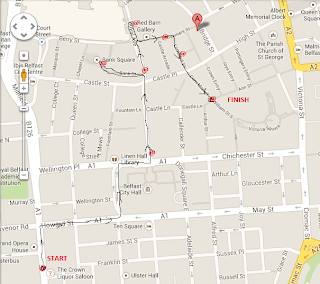Natural History Museum 2pm 23rd Oct 2014
The weather favoured us, a
fine autumnal afternoon in Dublin. The point of departure was the
affectionately know ‘Dead Zoo’ or Natural History Museum by Frederick Clarendon
on Merrion St. The location, housing stuffed specimens ranging from beetles to
badgers, was apt for our mission, to detect urban flora and fauna on route to
the LAB in Foley St.
A crowd of about 20 gathered
noting first the wealth of leaf motif detail on Frederick Clarendon’s building.
Merrion St and Merrion Square host a good range of trees, ash and sycamore
shedding their leaves as we leave the Museum grounds.
Of course the park is home
to an expected selection of deciduous trees but we are on the hunt for the
lesser spotted so we gave it a nod and moved on.
As we walk on north bound we
spot a shamrock motif repeating itself on the wrought iron railings and lampposts,
maybe something to do with our proximity to Leinster House. Buddleia, fern and dandelion sprouting at the
base of the occasional lamp post, railing or step act as a nice foil to the
well groomed formality of Merrion Square.
Domestic railings (as opposed to institutional railings) poised
on lion’s claws form grand surrounds to the rows of townhouses. Rounding Clare
St towards Kildare St we act on Rickie’s suggestion that we check out some
feral stonework on the Alliance Francais building. En route we note carved garlands of
fictitious fruits adorning the façade of the Lincoln’s Inn on Lincoln place. Twists of steel suggest a young leaf on a well-crafted
wrought iron cellar grill to our left. People are starting to look up and down now.
We arrive at Alliance
Francaise in all its Byzantine splendor (designed by Thomas Newemham Dean and
Benjamin Woodward). We are not disappointed. The premises, the former Kildare
Street Lords Club and one time bastion of the Ascendency, reposes on the corner
of Nassau and Kikdare St. Pillars are topped with exquisitely carved acanthus
leaves and tailed with a menagerie of mischievous animals encircling their
bases. This is the work of stone mason brothers John and James O'Shea.
Highlights include musical
shrews and billiard playing monkeys. It is rumored that the stonemasons’
services were dispensed with because irreverence and irony were not on the
club’s menu. A crouching and now headless devil figure gives for a last ironic nod
to the building’s past.
We proceed on down Nassau St
as various people discussed the merits of cutting through Trinity to take in
its grounds and landscaping but also in search of some more hidden gems. We clock
another abundantly adorned stone doorway on the corner of Nassau St and
For starters Denise draws
our attention to ‘Invasion’, a show by Lois Weinberge at the Douglas Hyde
Gallery on Trinity’s grounds. 45 leathery bracket mushrooms cling tenaciously
to the spartan walls of the smaller gallery. They will be there until 3rd
December.
We cross Fellow’s Square on
our way to another Newemham Dean and Woodward building. The Museum Building is
laden with opulent stone carved decorative motifs by the masons John and James
O'Shea who again surpass themselves. The carvings are in keeping with their
interest in the activities of animals and depict scenes from Aesop’s Fables and
imagery relating to Darwin's Theory of Evolution. This is also home to the
skeleton of a Red Deer. Its towering form greets you as you enter the building.
Other treats include a giant ammonite fossil casually leaning against the base
of the sweeping stone stairway.
Time is pressing on, there
is still a herb garden in the grounds of Trinity at the rear of the Science
Gallery before we see what offerings the Liffey and its environs have for
us.
Despite this we take a
minute out to savour a small quiet Rose Garden and are rewarded with a fungus,
which we couldn’t identify, growing at the base of a cherry tree. There is also
a type of wishing tree here votivelly strewn with reddish pink ribbons. People
speculated that it was decked out for cancer awareness day.
Moving on we reach the herb
garden where the herbs were identified with English and Latin markers. Some,
perhaps overcautious, signage warned that the plants are poisonous, but there are
plenty of kitchen garden staples there such as Rosemary and Thyme. A growing
apothecary for both the scholarly and culinary minded.
One of our company finds a
small, recently nibbled crab apple, squirrels perhaps? We pour out onto Pearse
St and head down Lombard St. We pass a dog walker and her small dog clad in
pink gingham. A coincidental but battered sign reminds us of the consequences
of not cleaning up dog poo.
A pair of clay pigeons are
perched symmetrically on 2 window ledges and then we hit the City Quay. Sean O’
Casey Bridge is undergoing renovation so we follow the keys down towards Talbot
Memorial Bridge taking in the seaweed clad tidal zone of the Liffey and some
surprisingly lichen clad trees.
Moss grows between the landscaped
cobbles near the junction of moss St. A cordyline
in a front garden is flanked by buddleia overhanging a neighbouring wall. Time
to head over the bridge, taking in the lion and unicorn heraldry on the Custom
House as we go.
North Side, nearly back now.
Weeds are beating laurels in a growth battle outside the AIB International
Centre. I had never quiet taken in the colourful, styalised leaf motifs across
the road on Michael Scott’s Busarus roof top overhangs.
Amiens St brings us to
Talbot St. where a new second hand shop stocks a menagerie of brass. A camel
catches our eye. We cant leave the urban
setting without siting and recording at least one pigeon. Its getting bracing
now we welcome our warm return to the LAB on Foley St.

